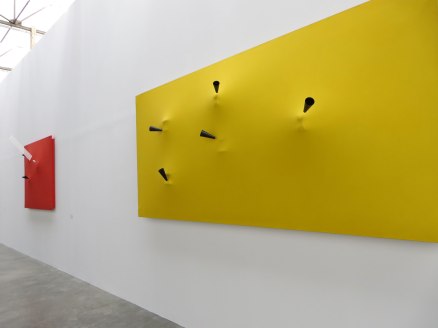 |
| Takis, Télépeintures, installation view |
There are few artists working today whose
work continues to surprise and delight its audiences. When I say “surprise,” I
do not refer to works that shock or engage their audience in some kind of intellectual
dialogue on morality, politics and culture. I mean surprise in the most joyful
of ways. And what makes Takis’ works resonate long after we have left the
Palais de Tokyo is that they continue to reveal their invisible layers of
enchantment. For works that present as clinical and scientific and mathematically,
rationally structured, Tarkis' installations, sculptures and environments are
remarkably human and playful. That’s what makes them exciting.
| Takis, Signaux, et Peintures Vue de l'Exposition |
As I thought about the works after I
had left the museum, every thought I had turned into its opposite over time. For
example, in works that claim to be concerned with questions of
invisibility, these works are extremely visual. I watched visitors sitting in
the environment created inside the Palais de Tokyo listening to the sound
installation, Sculptures Musicales.
Inevitably, they (and I) couldn’t resist the temptation to walk up to the white
panels on which a needle is pulled to a wire by a magnet behind the panel, to
see how it works. Thus we all looked for a visual explanation to a sonic performance. Or
alternatively, in the Télépeintures magnets deform the solid coloured canvas behind which they are hidden
when they attract metal cones supported at a distance on the ceiling. The strange
shaped canvases are infinitely fascinating because although we cannot see how
the attraction is created, we understand that it is, and thus, we continue to
investigate through vision what we cannot see.
 |
| Takis, Gong |
All of Takis’ works on display here sit at
the crossroads between science and art, rationality and creativity. Again, in
the case of the Telepeintures, we
begin by looking for the physics of these strange sculptures, and yet, we find elements
held in place by magnetic elements, that lead to a discourse on gravitation,
orientation, a discourse that tells of our invisible and inexplicable
attraction to each other, our limitation as humans. Another discourse hidden
from the eye, one that becomes very obvious very quickly is that of the
relationship between people, its inexplicability: the force field that
surrounds or attracts two people, a person to a thing is never visible, not
something we can figure out, it’s just there, and it is irresistible, timeless.
 |
| Takis, Magnetic Sheet, 1971 |
In another example in which nails are available
for the visitor to throw against a metal sheet with magnets placed strategically
at certain points behind the sheet, appears, at first sight to be a discourse
on some kind of scientific logic about what makes nails stick to a metal sheet.
But then, in time, we recognize the piece as a conceptual reflection on our
experience, it becomes a discourse of aggression towards the museum. Or perhaps
visitors understand the piece as I did when I was reminded of the side show when we
shoot the ducks or try to get the balls into the clown’s mouth. We have to aim
right to get the nails to stick to the metal at the point where the magnet is,
and it’s so difficult to win. When all the nails fall into the gutter below the sheet, we understand that attraction is never a guarantee.
| Takis, Sculpture Musicale, 1977 |
For Takis, the invisible energy that
creates the rhythms and resonance of a gong as it hits a cymbal, the arrows that
kill St Sebastian, or the erotic desire that propels sexuality and sexual
intercourse, are all driven by the same invisible force. All of the signs, signals, whether they be
philosophical, astronomical, physical, mythical, are organized by invisible
energies that we can never fully comprehend. And even if we do, they are likely
confuse so that comprehension is only ever fleeting.




